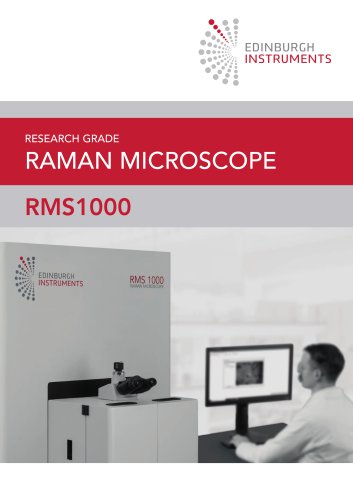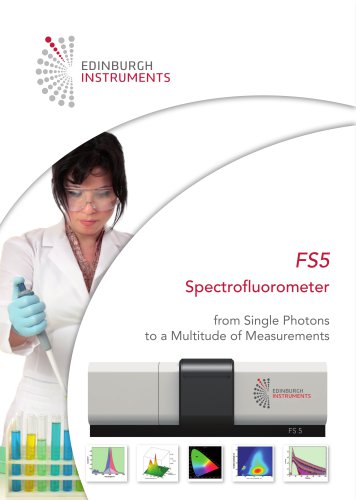 Website:
Edinburgh Instruments
Website:
Edinburgh Instruments
Catalog excerpts

EDINBURGH INSTRUMENTS
Open the catalog to page 1
Faster Measurements Higher Resolution Increased Automation The FLS1000 is a state-of-the-art, modular photoluminescence spectrometer for the most demanding applications in Photophysics, Photochemistry, Material Sciences and Life Sciences. The instrument sets the standards in both steady state and time-resolved spectroscopy: The system demonstrates unmatched sensitivity and can be configured for spectral measurements from the ultraviolet to the mid-infrared spectral range, and for lifetime measurements spanning time resolutions over 12 orders of magnitude from picoseconds to seconds. STEADY...
Open the catalog to page 2
Material Sciences • Phosphors for the Lighting and Display Industry • Doped Glasses and Ceramics • Laser Crystals and Light-Emitting Materials • Semiconductors Manufacture and Diagnostics • Materials for Light Harvest, Energy Conversion and Energy Storage • Fluorescent Inks Life Sciences • Fluorescence Based Assays • Drug Discovery • Detection of Toxins • DNA Sequencing • Research of Molecular Processes and Mechanisms • Photosensitisers Research • Singlet Oxygen Detection Environmental Sciences • Photo-oxidation of Environmental Pollutants • Detection of Total Organic Contents • Detection...
Open the catalog to page 3
PHOTOLUMINESCENCE OF LANTHANIDES - UPCONVERSION Lanthanide materials have wide applications in the lighting industry, as laser gain media, in solar cells, as fluorescent labels, and in the life science industry as sensor materials. The electronic structure of lanthanide materials causes bright emission that often can have narrow-band structure and can favour non-linear upconversion processes. APPLICATIONS IN MATERIAL SCIENCES The FLS1000 offers exceptional high spectral resolution, provides stray light suppression to discriminate between weak emission and scatter from the white powder...
Open the catalog to page 4
EMISSION OF SEMICONDUCTOR MATERIALS AT ROOM TEMPERATURE A large variety of inorganic materials show semiconductor properties. The emission from these materials at ambient temperatures can be strong or extremely weak, depending on the physics of inter-band recombination, the presence of defects and impurities. Often these materials come as white powders and a clear separation of the potentially weak emission from unwanted scatter may be challenging. Double monochromators or lifetime measurements are effective in discriminating from scattering artefacts. Semiconductor Band-Gap Spectral and...
Open the catalog to page 5
LIGHTING INDUSTRY PHOSPHORS Light emitting powders can have strong emission; therefore, accurate determination of their reflection and absorption properties can be challenging. Using the integrating sphere and specially configured synchronous scans, spectral reflectance and absorbance can be reliably obtained. Normalised Absorbance Normalised Reflectance YAG:Ce phosphor powder in BaSO4 at various concentrations. Quantum Yield (%) APPLICATIONS IN MATERIAL SCIENCES Measurements of absolute photoluminescence quantum yield require high precision in the measurement of both weak and strong...
Open the catalog to page 6
CARBON NANOTUBES The mapping function in the Fluoracle software, together with the instrument's unsurpassed resolution and NIR spectral coverage, make the FLS1000 an excellent tool to study these materials. Nanoscale materials such as quantum dots, carbon nanotubes, nanoparticles and nanostructures exhibit strong spatial confinement upon photo-excitation and tuneable emission. This makes them excellent candidates in a multitude of applications from photonic devices to sensing and biology. The structural characteristics of single-walled and multiwalled carbon nanotubes can be identified from...
Open the catalog to page 7
ABSOLUTE QUANTUM YIELD MEASUREMENTS OF ORGANIC DYES The figure shows the independence of the fluorescence QY from the wavelength of excitation for a standard organic dye. The areas of absorption for eight different excitation wavelengths and the corresponding emission spectra, scaled by a factor of 5, are shown. The inset shows the calculated quantum yields. Quantum Yield The absolute method for fluorescence quantum yield (QY) measurements is now more widely used than the relative method. It does not require a QY standard and readily applicable to liquids, films and powders and can be...
Open the catalog to page 8
SOLVENT RELAXATION DYNAMICS OF ORGANIC DYES Fluorescence kinetics can be complex for homogeneous dye solutions in polar solvents, even if rotational diffusion is eliminated with magic angle conditions. Synthetic Dyes The measurement shows 16 fluorescence decays in a polar-viscous solvent of glycerol containing one fluorophore species, with multi-exponential decays at shorter wavelengths and rise-decay kinetics at longer wavelengths. The TRES mapping option in Fluoracle enables quick data acquisition, while the FAST package allows performing complex analysis. Using globally linked...
Open the catalog to page 9
EMISSION OF SINGLET OXYGEN By measuring time-resolved spectra the singlet oxygen emission can be discriminated from the background. Time-resolved singlet oxygen measurements are challenging as the emission at ~1270 nm is very weak. The emission lifetime is solvent dependent and becomes comparatively short in aqueous solutions. The figure below shows a time-resolved singlet oxygen emission measurement with exceptionally high temporal resolution. An instrument configured with a nanosecond laser source and MCS detection is the best choice for this type of measurement. A wide variety of ns...
Open the catalog to page 10
RED-EDGE EXCITATION OF PROTEINS The FLS1000 with its outstanding sensitivity and its automated measurement functionality is an excellent tool for red-edge excitation fluorescence spectroscopy; even for very low concentrations of the protein under investigation. Biomolecules Emission peak wavelength / nm Red-edge excitation fluorescence spectroscopy is a powerful method to study structure and dynamics of biological membranes, micelles and proteins. In protein research, this method takes advantage of the possibility to selectively excite a small fraction of specifically located tryptophan...
Open the catalog to page 11All Edinburgh Instruments catalogs and technical brochures
-
RESEARCH GRADE RAMAN MICROSCOPE
16 Pages
-
LP980 Spectrometer Brochure
20 Pages
-
MTL 5 Series
2 Pages
-
PL Series
4 Pages
-
FIRL Series Flyer
2 Pages
-
Mini T
2 Pages
-
Life Spec II
4 Pages
-
FS5
12 Pages
-
FLS1000
24 Pages
-
FS5 Spectrofluorometer
12 Pages
-
Blue Wave Full Specification
2 Pages



















